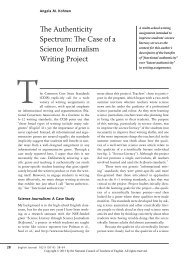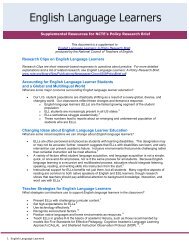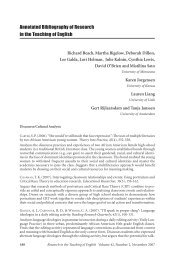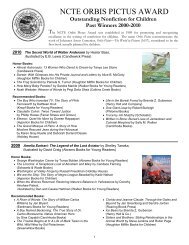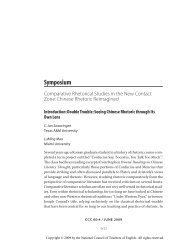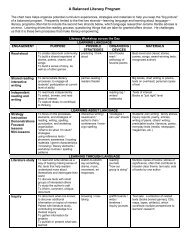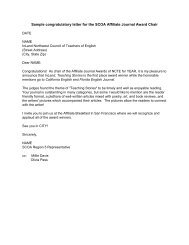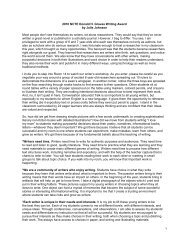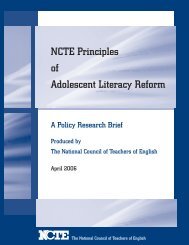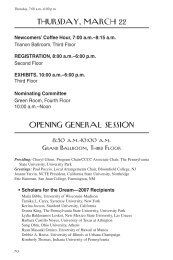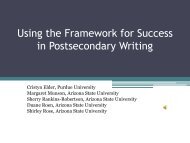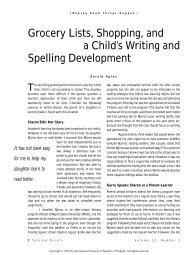Annotated Bibliography of Research in the Teaching of English
Annotated Bibliography of Research in the Teaching of English
Annotated Bibliography of Research in the Teaching of English
- No tags were found...
Create successful ePaper yourself
Turn your PDF publications into a flip-book with our unique Google optimized e-Paper software.
<strong>Annotated</strong> <strong>Bibliography</strong> 217HICKS, D. (2005). Class read<strong>in</strong>gs: Story and discourse among girls <strong>in</strong> work<strong>in</strong>g-poor America.Anthropology and Education Quarterly, 36(3), 212-229.Analyzes a group <strong>of</strong> work<strong>in</strong>g-class, late-elementary-age students’ literary responses, writ<strong>in</strong>g,and identity construction, students with whom <strong>the</strong> researcher worked with over a four-yearperiod. F<strong>in</strong>ds that her students enjoy writ<strong>in</strong>g and shar<strong>in</strong>g horror fiction that dramatizes violencederived from popular culture versions <strong>of</strong> horror fiction, as well as shar<strong>in</strong>g responses tomore canonical literary texts. The mesh<strong>in</strong>g <strong>of</strong> <strong>the</strong> researcher’s own middle-class discourses andturn-tak<strong>in</strong>g practices with <strong>the</strong> students’ work<strong>in</strong>g-class discourses and language use created acarnivalesque (Bakht<strong>in</strong>ian), bil<strong>in</strong>gual hybrid discourse for negotiat<strong>in</strong>g differences between homeand school cultures. Suggests <strong>the</strong> need to import “<strong>the</strong> real” from popular culture <strong>in</strong>to <strong>the</strong> classroom.MCINTYRE, E., KYLE, D. W., & MOORE, G. H. (2006). A primary-grade teacher’s guidance towardsmall-group dialogue. Read<strong>in</strong>g <strong>Research</strong> Quarterly, 41(1), 36-66.Describes <strong>the</strong> behaviors and language used by one 2nd-grade teacher to promote small-groupdialogue about mystery books and related literary concepts. Analysis <strong>of</strong> teacher-student talksuggests that teacher-fronted discourse can be important to achiev<strong>in</strong>g students’ eventual participation<strong>in</strong> true dialogue. F<strong>in</strong>d<strong>in</strong>gs also suggest that <strong>the</strong> use <strong>of</strong> non-evaluative responsesand l<strong>in</strong>guistic and paral<strong>in</strong>guistic cues can help scaffold students’ participation <strong>in</strong>to genu<strong>in</strong>eclassroom dialogue.MIKKELSEN, N. (2005). Powerful magic: Learn<strong>in</strong>g from children’s responses to fantasy literature.New York: Teachers College Press.Analyzes children’s responses to picture books, <strong>in</strong> which students expressed responses throughstories, draw<strong>in</strong>g, or drama; 2nd grade students’ responses to seven re-read<strong>in</strong>gs <strong>of</strong> Louis <strong>the</strong> Fish,and changes <strong>in</strong> responses <strong>in</strong> <strong>the</strong> same two males at ages 5 and 7 and ages 7 and 13 to two fantasynovels. F<strong>in</strong>ds that employ<strong>in</strong>g imag<strong>in</strong>ative approaches and texts can foster rich responses <strong>in</strong>children.PACE, B. G. (2006). Between response and <strong>in</strong>terpretation: Ideological becom<strong>in</strong>g and literacyevents <strong>in</strong> critical read<strong>in</strong>gs <strong>of</strong> literature. Journal <strong>of</strong> Adolescent & Adult Literacy, 49(7), 584-594.Draws on Bakht<strong>in</strong>’s notion <strong>of</strong> “ideological becom<strong>in</strong>g” to consider how dialogic exchanges focusedon works <strong>of</strong> literature can support or subvert critical understand<strong>in</strong>gs. Analyzes two femalecollege students’ responses to “The Yellow Wallpaper” (Gilman, 1899) to determ<strong>in</strong>e how<strong>the</strong>y changed <strong>the</strong>ir critical stance on <strong>in</strong>equities <strong>in</strong> gender and marriage as <strong>the</strong>y participated <strong>in</strong>post-read<strong>in</strong>g events <strong>in</strong> <strong>the</strong>ir literature class. F<strong>in</strong>ds that <strong>the</strong> students shifted away from voic<strong>in</strong>g an<strong>in</strong>itial critical stance after participat<strong>in</strong>g <strong>in</strong> a class discussion to adopt a read<strong>in</strong>g that reflecteddom<strong>in</strong>ant ideologies, reflect<strong>in</strong>g <strong>the</strong> <strong>in</strong>fluence <strong>of</strong> “norm<strong>in</strong>g” effects <strong>of</strong> group attitudes. Suggeststhat literature teachers who <strong>in</strong>troduce multiple perspectives need to have explicit strategies forsupport<strong>in</strong>g students’ emerg<strong>in</strong>g critical perspectives.SMITH, M. W., & CONNOLLY, W. (2005). The effects <strong>of</strong> <strong>in</strong>terpretive authority on classroom discussions<strong>of</strong> poetry: Lessons from one teacher. Communication Education, 54(4), 271-288.Studies <strong>the</strong> effect <strong>of</strong> three different teacher authority conditions on two 9th grade classes’ discussions<strong>of</strong> poetry: <strong>the</strong> teacher taught 1) a poem he had written, 2) a poem he had taught manytimes previously, and 3) a poem that he saw for <strong>the</strong> first time along with his students. Analyzesturn-tak<strong>in</strong>g, k<strong>in</strong>ds <strong>of</strong> reason<strong>in</strong>g, and knowledge sources <strong>in</strong> <strong>the</strong> discussions. F<strong>in</strong>ds significantdifferences <strong>in</strong> treatment effect; <strong>the</strong> condition <strong>in</strong> which <strong>the</strong>re is less <strong>in</strong>fluence <strong>of</strong> teacher authorityfosters more student dialogue, although <strong>the</strong> treatment effect can vary accord<strong>in</strong>g to differences<strong>in</strong> <strong>the</strong> social dynamics at work <strong>in</strong> discussions.



